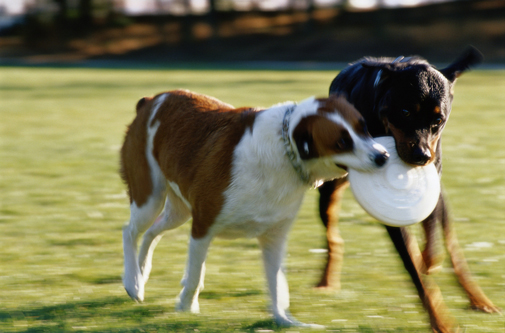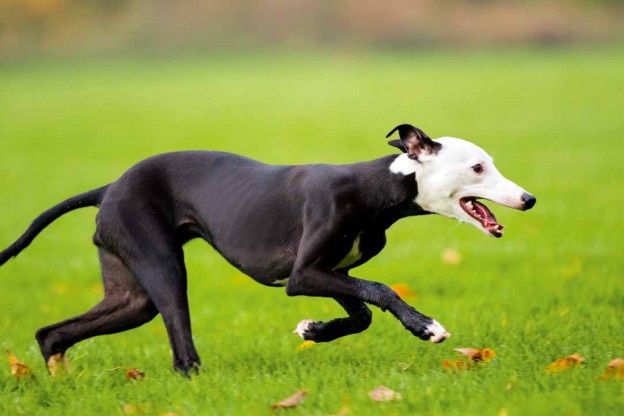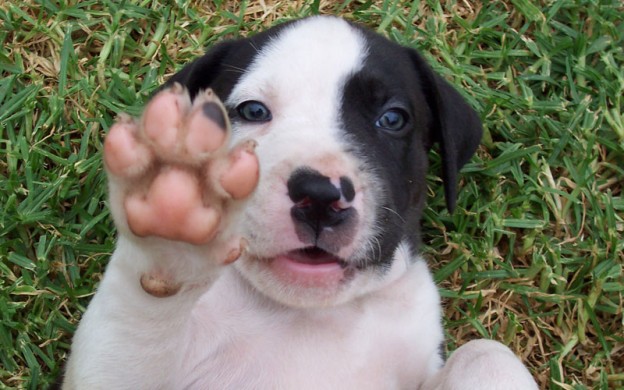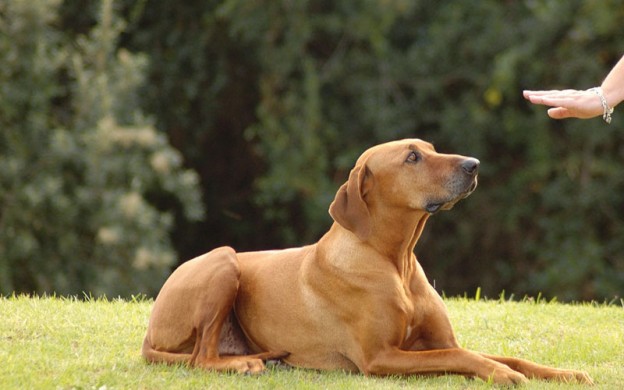
Many dog guardians would love to teach their dog to retrieve. With a little bit of patience and dog training on retrieval, Dogs Life will have your dog, young or old, retrieving the ball in no time at all.
Teaching a dog to retrieve comprises many things. The two main things to remember are consistency and frequency. Trainer Karin Bridge tells Dogs Life of the most common mistakes people make.
“If your dog isn’t keen on retrieving the big secret is to do little, often,” she says. “If you can get them first to just look at the toy with their eyes, then touch it with their nose, then make a big fuss when they show any interest in it. If you do too much too soon they’ll loose interest. I think the majority of people do too much too quickly.”
You also need to know what your dog likes to play with, as some dogs don’t like to pick up certain textures. With so many toys and doggy products on the market it’s easy to go wrong with a texture your dog doesn’t like.
“Texture is important,” Karin stresses. “Find a texture your dog likes. Most dogs will start with soft toys initially. Some don’t like plastic and some dogs love wood and hate anything else.
Most dogs like tennis balls, but it does vary. “So think about plastics, wood, furry, squeaky. Often squeaks will attract them, but some dogs are put off by the squeak. They’re all different and people need to play around with what their dogs like.”
Before getting started
Before you start to train your old or young dog how to retrieve you really do need to consider what the retrieval will be used for. If your dog is going to learn formal retrieval then you need to start putting this into practice right from the word go. Formal retrieval is when the dog not only brings the object back, it also waits for a signal to release and may even release into your hand.
“There are two major differences between whether you’re teaching a formal retrieval or an informal retrieval,” Karin says. “A formal retrieve for obedience is when the dog picks it up on command whether it’s moving or not, comes and brings it to you, usually sits in front and holds on to it until you ask it to release.
“This is also really, really important, especially when training dogs for the disabled, as there is no point them bringing you a wallet if they drop it six inches in front of you. This is also not taken well in the obedience ring.” However, if you’re training for fun purposes and just want to get your dog to pick the object up and return it to you so you can play a game of fetch, training is much easier.
“For most people, an informal retrieve is fine, where the dog can run after it as soon as you throw it and the dog doesn’t have to wait for you to say ‘fetch’,” Karin tells Dogs Life. The main difference between an informal retrieve and a formal retrieve is when the dog comes back to you it can just drop the ball at your feet without waiting for a release command.
“For most people who just want to exercise the dog and have a bit of a game it’s actually easier if they drop it at your feet than have a slobbery ball dropped into your hand,” Karin laughs. “For a formal retrieve you do have to work a lot more on getting the dog to keep holding it until he hears the release word.”
Getting started – puppy
If you have a young pup and you want to start teaching him to retrieve there are some points to consider. Usually, young pups will prefer a soft toy to play with. Make sure the game is always fun. Use your best happy voice and remember to praise the behaviour you want and ignore the behaviour you don’t like, such as running away with the object in the hope of a “chase me” game.
“I would start as soon as possible, as soon as I get hold of the puppy,” Karin says.
The most important thing is never to punish the pup for holding anything in its mouth, even your best pair of shoes! “A lot of people make the mistake of punishing their pup for picking up a shoe or a sock or something. This discourages them from putting things in their mouths.”
This is especially true if you’re doing any formal training with your dog and you want it to pick up different articles such as the newspaper. “If you’re training dogs for the disabled you’d want your dog pick up everything, so you don’t want to discourage your dog from picking up different materials.”
Instead of punishing your puppy for picking up your shoes or socks, praise him for showing it to you and brining it to you. The key here is not to chase your puppy around the home screaming “COME!” This will only encourage your pup to keep running as he’s just persuaded you into a game of chasey — every pup’s favourite game!
“The main thing you want to encourage is that they show it to you or give it to you,” Karin suggests. “I’d much rather have a dog pick up my expensive shoes and say, ‘Oh here, mum, look what I’ve got for you,’ rather than say, ‘Ha, ha, catch me if you can,’ because they’ve been roused on for running off with it.”
Also monitor your young pup. Where does he put his toys when he plays with them? Many pups will have a lair or a special place they hide all their toys such as in their bed, under the couch, under the coffee table. This is an important indication as to where to stand when playing your initial games of fetch.
“If you hang around that lair when you throw the toy they’ll probably come it back to it,” Karin recommends.
But remember you don’t want to teach your young pup that fetching a toy means you’ll take it off them straightaway, otherwise they’ll never bring it to you.
“Don’t grab at [the toy] right away; wait your time. When the dog has lost a bit interest in it and you’re not overly interested in it, then it’s a good time to pick it up and throw again. This is a good way to start with a puppy.”
Then throw it again and, once your puppy has picked up the toy and is on its way back, make sure you use plenty of encouragement. In other instances — say your pup has just discovered those sweetly smelly dirty socks at the back door — call him to you in a happy voice and remember not to chase him.
“I would call them to me and say, ‘Oh, look what you’ve got, what a clever puppy,’ and then swap it for something of equal or better value,” Karin says. “So either give them a treat or, if it’s something they can have, I’d have a look at it then give it back to them.”
Repeat this five times per day. You need to remove the toy and stop the game while the pup is still interested. This keeps him keen on learning next time around.
Important – retrieval toys
It is vitally important that your retrieval toys are not ordinary “chew” toys. These toys are your toys. They only come out when you’re around to interact with the dog and are put away immediately after you finish playing the game. Any toy can be used for the game of fetch, but never leave those toys around for your dog to chew or play with — otherwise you’ll loose your main interest point.
“After I’d done a few throws I would take the toy away as I want to keep it special and I’d want to keep it as an interaction between the two of us,” Karin suggests. “Just lying around, the toy will become their toy and it’s not as special, so to keep them keen on it I would actually put it away.
“I’d do five or six with the dog coming back to the lair (for a pup, or to you for an older dog). Then, while they’re still enjoying the game, I’d remove the toy.”
Keeping interactive toys under lock and key has huge benefits for both you and your dog. Not only will his toys last longer and he’ll get to play with them more, it’s really instigating who’s boss in your pack. As your dog’s leader you’ll have control over the interactive games you play and you’ll decide when you play and when you don’t play.
This can also help with many dogs that get “ball obsessive” and want to play fetch all the time. By removing the toys you are removing the interactive game and prolonging your dog’s interest in the toy and game.
“Any toys that aren’t interactive — things like marrow bones, Kongs, and one soccer ball they can kick around themselves if they’re that way inclined — that’s fine as they need chew toys and stuff,” Karin advises. “But toys that are interactive, that are going to be fetch toys, they’re mine and he just gets to play with them sometimes.”
Teaching an old dog new tricks
All dogs have different ideas about the game of fetch. Some believe the game is a snatch-and-grab type that progresses into a game of chase. Others will enthusiastically chase the ball only to come running back empty-handed — or should we say empty-mouthed.
“You get the two types of dogs,” Karin smiles. “You get the ones that are super-keen, dogs that think, ‘This looks like a great game, this is my toy, catch me if you can,’ that sort of thing. Then you also get the dogs that think, ‘Well, why would I want to chase that?’ So the way you train the two types is quite different.” We’ll start with the most common: the dog that’s not interested at all. For such dogs you need make the game exciting and fun.
You really have to remember to praise your dog for picking up the object in his mouth. Make sure you find an object he’s comfortable with holding between his jaws. Start with praise for touching the object and progress until your dog has gone from stronger touches to actually having his teeth on the toy. Eventually your dog should feel comfortable picking up the object. Just keep up the words of encouragement and praise.
Remember not to overdo it — you don’t want your dog getting bored.
“For most people it’s the opposite problem for dogs: [rather than the dog refusing to release the object] they might go and get it while it’s moving but then they’ll loose interest,” Karin says. “So the big thing is to remember to praise while it’s in the dog’s mouth.”
You can also pop your dog on a short lead and encourage your dog to carry the object around in his mouth, remembering to praise all the way. “Another thing you can do, depending on the dog, is to have the dog on leash,” Karin advises. “Encourage him to pick it up and walk around with it on leash for a little bit and say, ‘Oh, look at you, aren’t you pretty?’ Some dogs are better when they’re moving holding the dumbbell, rather than sitting in front of you.”
It’s also a good idea to do this kind of training just before dinner time.
Then the dog is working for his meal and being rewarded for retrieval. “If he’s willing to put his teeth on the retrieve article a couple of times or hold it for a few seconds then give him his dinner,” Karen says. “They call it grandma’s rule: if you eat your veggies you can have your dessert.” Once your dog is comfortable picking up the object you can move on to the retrieval steps.
Different methods
There are many different methods in teaching your dog to retrieve. The important thing to remember is never commit to a game of “catch me if you can”. If your dog does get hold of the object and run off with it, ignore the behaviour and stop playing the game.
“Most dogs love the game ‘catch me if you can’ and if they can get you to chase them they will,” Karin smiles. “One of the common mistakes people make when they’re teaching retrieve is to indulge in this game and it ends up being ‘catch me if you can’ and not ‘retrieve’.
“You have to teach the dog that you’re not really all that interested in the toy. You need the dog to realise the only way it’s going to be fun is if the dog brings it back to you so you can keep throwing it.” So how do you begin? There are a few methods, including using a light line or long lead, or two toys of equal value.
* The first one is quite simple. Attach a light drag line or lead to your dog. Throw your object away from you and your dog and use a key word such as “fetch”. Once your dog has picked up the object, coax him back using plenty of praise. If he goes to make a dash with the toy, slowly reel him in using the line or lead while calling him to you. You can use words like, “Rover, fetch” or “Rover, come.” Repeat five or six times, but remember to stop before your dog gets bored. This can be done once or twice a day until your dog begins to understand the game. However, it must be done consistently. Once a day for two weeks would be perfect; if you leave it too long between sessions your dog is more than likely to forget the exercise. “One of the things you can do is to work on a light line, a five-meter drag line, or you could start on a short leash,” Karin suggests. “Throw the ball a little way and then call the dog to you when it’s in his mouth so he doesn’t learn it’s an option to run away with it.”
* The second is to have two toys of similar value, such as two tennis balls or doggy balls. You can even use squeaky toys or soft plush toys — whatever your dog is more comfortable holding in its mouth. The important thing is that they not be exactly the same and hold the same amount of value to your dog. “Another great game is the ‘two toys of equal value’,” Karin says. “If your dog has a toy he really likes, say a tennis ball, then you get two exactly the same and you throw one for him. He runs off after that one and thinks, ‘Ha, ha, I’ve got the toy — catch me if you can!’ Then you pick out of your pocket the exactly similar toy you still have, and yours is more exciting because you can make yours fly [be thrown] and he can’t make his fly because he’s a dog. He’ll think you’re pretty amazing because he thought he had it but now you have the ‘good’ one. So he’ll loose all interest in the one he has and then you can throw the second toy the other way. While he’s getting that you can go and get the other one.”
You can also use this method to get the dog to come back to you during the game. Use a word such as “release” when he lets go of the toy. Sooner or later your dog will realise the fun in the game is you throwing the toy, not the toy itself. This is also a great way of keeping your dog in check with you as he’ll always be looking to you to see if you have that magical toy. Plus you’ll be preventing the game “catch me if you can” from interfering with your game of fetch.
With consistency and patience your dog will be retrieving in no time. Remembering basic things such as keeping the retrieval toys separate and not expecting too much too quickly from your pooch will make this training exercise much easier. Make it fun for the both of you and remember that all dogs are different and learn at different paces.
If you dog already has a deep-rooted desire for the game “catch me if you can” it may take a little while longer to teach him the new ways of the game.
“There’s a huge difference from dog to dog [in learning to retrieve],” Karin says. “It all depends how big a chase drive they have and how willing they are to put their mouth on things. Some retrieves you’ll do in a day, and with some dogs you’d have to do it in tiny little steps.”
This is probably the main reason many training clubs don’t spend much time on retrieval, as every dog is different. Some dogs may have an issue with giving up the ball while others won’t want to put their jaws anywhere near the object in the first place. Finding out what type of method best suits your dog will be a rewarding exercise in the end.
Also, many dogs won’t take to someone shoving a toy in their face too well. Dogs love moving objects so it’s always better to have the object moving to encourage your dog to pick it up. Even throwing the ball in the air a few times then handing it over and inviting your dog to walk around with it can help with dogs who don’t like to pick up objects.
Other benefits of retrieval
Teaching your dog to retrieve has many benefits. Not only will it keep you and your dog active, it’s also a great way to bond with your dog. Retrieval is a wonderful leadership exercise and really allows you to interact with your dog in a great way.
It’s also a wonderful game for children to play with a dog, especially ones who are afraid of dogs. To allow them to see that the dog is only interested in one thing — the ball being thrown — can enlighten children. This is a great game kids can play with their dogs and a very safe one, if taught correctly. However, children should be supervised around any dog.
“My old Golden Retriever loves to retrieve and kids first of all think she’s so smart!” Karin laughs. “Kids who are scared of dogs, once they realise we’re playing a ball game, something they can relate to, suddenly they’re not frightened any more. She’s not chasing them, she’s not interested in them, she’s just interested in the ball. It seems to build confidence in them.”







